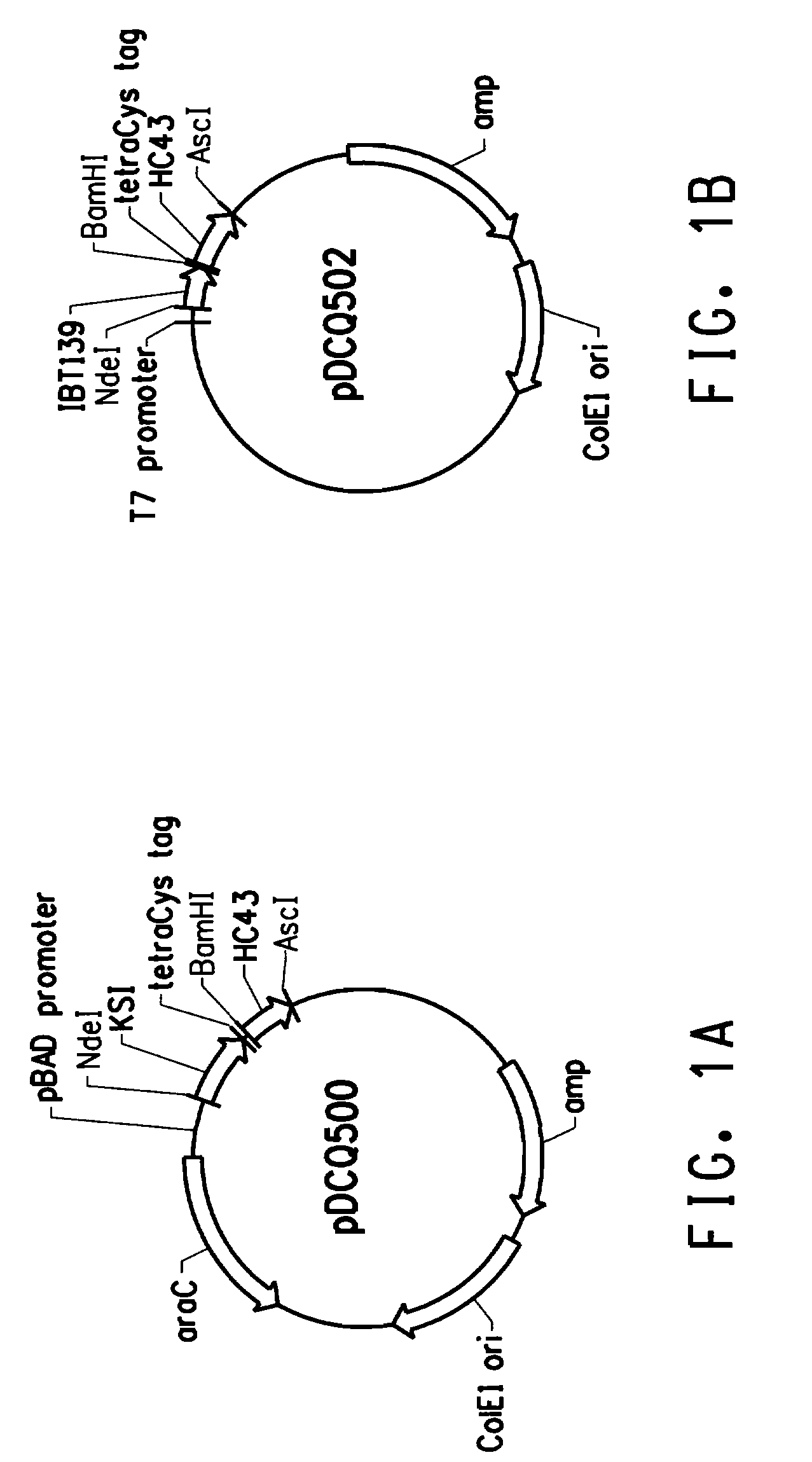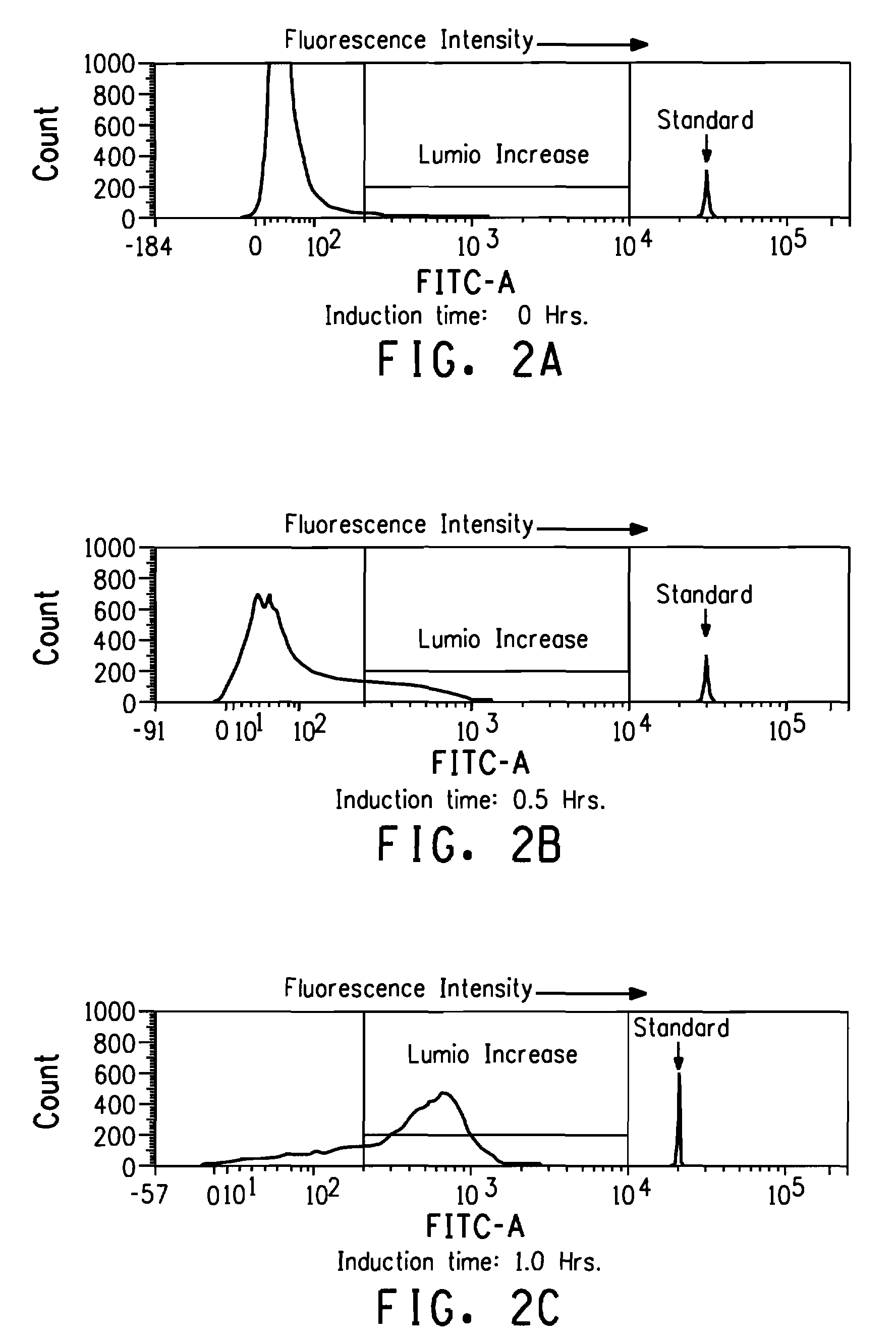Use of tetracysteine tags in fluorescence-activated cell sorting analysis of prokaryotic cells producing peptides or proteins
a technology of tetracysteine and prokaryotic cells, which is applied in the field of in vivo detection of recombinantly produced peptides or proteins, can solve the problems of limited production capacity, high method cost, and inability to detect short peptides produced in a cellular environment, and achieves the effect of fast and efficient detection and selection
- Summary
- Abstract
- Description
- Claims
- Application Information
AI Technical Summary
Benefits of technology
Problems solved by technology
Method used
Image
Examples
example 1
Specific Labeling of Tetracysteine Tagged Fusion Peptides
[0212]This example describes cloning of the tetracysteine tag (CCPGCC; SEQ ID NO: 2) into three peptide expression plasmids in E. coli, which allowed specific labeling of the fusion peptides.
[0213]Specific labeling of proteins or peptides could be achieved by biarsenical ligands binding to tetracysteine tag (CCX1X2CC, SEQ ID NO: 1; wherein X1 and X2 are any amino acid other than cysteine, preferably X1X2 is PG; respectively (SEQ ID NO: 2)), which is genetically engineered into the target protein or peptide. The fluorescein derivative with two As(III) substituents, FlAsH-EDT2 (LUMIO™ Green), only fluoresces after the arsenics bind to the cysteine thiols in the target protein or peptide. In order to reach high production yield and reduce separation costs, peptides of interest were produced as inclusion bodies in our E. coli production hosts. Inclusion body promoting sequences were usually fused to the N-terminus of the peptide o...
example 2
In Vivo Fluorescent Labeling of E. coli Cells Producing the Tagged Peptides Visualized by Fluorescence Microscope
[0216]To explore if the live E. coli cells producing the tetracysteine-tagged peptides could be labeled in vivo without cell lysis or membrane permeabilization, we performed the labeling of the live E. coli cells using the LUMIO™ in-cell labeling kit (catalog no. 12589-057) or the TC-FlAsH™ TC-ReAsH™ II in-cell tetracysteine tag detection kit (catalog no. T34561) from Invitrogen, which are designed for labeling mammalian cells in vivo. The E. coli cells were grown and induced as described above. Normalized amounts of 100-200 μL of OD600 0.01 cells were pelleted and used in labeling reactions containing 1×PBS, 0.2% L-arabinose, appropriate antibiotics, 1 μM TCEP (Tris[2-carboxyethyl]phosphine) and 10-20 μM LUMIO™ reagent. In the only report of LUMIO In-Cell labeling in E. coli, Ignatova and Gierasch (PNAS 101 (2):523-528, 2004) used much higher concentrations of the labeli...
example 3
FACS Analysis of LUMIO™-Labeled E. coli B Cells
[0218]E. coli BL21-AI cells containing the pDCQ502 and the parent pTG34 plasmids were grown to OD600 about 0.5 and either continue to grow as un-induced or induced with 0.2% L-arabinose for 2.5 hours. Cells were then normalized to OD600 of 0.01 and were labeled by LUMIO™ in vivo as described in Example 2. Approximately 105-106 labeled cells were analyzed with a FACS Vantage™ SE with Digital Vantage manufactured by Becton Dickinson (BD Biosciences, Franklin Lakes, N.J.). The FACS instrument was configured and aligned as described in the General Methods. Twenty-thousand events were recorded for each sample. Data summarized in Table 3 showed that E. coli BL21-AI cells containing the pTG34 plasmid (i.e. the plasmid does not contain the nucleic acid sequence encoding the tetracysteine tag) were not labeled by LUMIO™ Green. Induced BL21-AI cells containing the pDCQ502 plasmid encoding a fusion peptide comprising the tetracysteine tag (CCPGCC;...
PUM
| Property | Measurement | Unit |
|---|---|---|
| temperature | aaaaa | aaaaa |
| pH | aaaaa | aaaaa |
| temperature | aaaaa | aaaaa |
Abstract
Description
Claims
Application Information
 Login to View More
Login to View More - R&D
- Intellectual Property
- Life Sciences
- Materials
- Tech Scout
- Unparalleled Data Quality
- Higher Quality Content
- 60% Fewer Hallucinations
Browse by: Latest US Patents, China's latest patents, Technical Efficacy Thesaurus, Application Domain, Technology Topic, Popular Technical Reports.
© 2025 PatSnap. All rights reserved.Legal|Privacy policy|Modern Slavery Act Transparency Statement|Sitemap|About US| Contact US: help@patsnap.com



